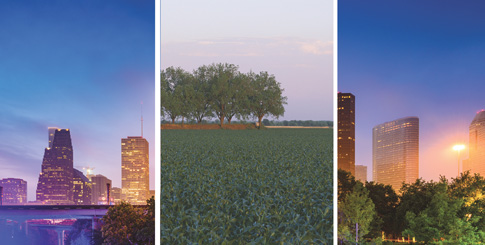The Original Terminal Market
While all the latest buzz may be about the Alamo City’s new wholesale market, there’s a longstanding terminal market across town. Opened in 1951, the San Antonio Produce Terminal Market continues to be a bustling, busy center for wholesale produce and related businesses.
According to Tom Preston, administrative director, San Antonio’s terminal market encompasses 39 acres and is fully occupied by 20 businesses that receive produce from Mexico, Central and South America, and around the United States for distribution locally and around Texas.
As for the new market in town, Preston isn’t worried. “Demand and business are both growing,” he says. “I think there’s room enough for everybody to do well.”
In addition to the two wholesale markets, San Antonio also boasts the largest Mexican market in the United States. Named El Mercado, it occupies a three-block section of the city in an outdoor plaza, with as many as 100 eateries, shops, craft stalls, and fresh produce stands filling the space.
Retail Competition
Even as the wholesale marketplace is working to reinvent itself, the retail side of the industry has grown at a frantic pace. There are a considerable number of national supermarket chains, homegrown favorites, independents, and grocery-themed invaders from other states and countries. Big box formats are alive and well too, as are hybrid convenience stores adding shelf space for more fresh fruit and vegetables and grab-and-go snacks and meals.
In addition, there are nearly two dozen active farmers’ markets across the metro area, drawing plenty of health-minded San Antonians to their fresh offerings. Among the notable are the uber-trendy Pearl Farmer’s Market at the renovated Pearl Brewery retail complex north of downtown; the Main Plaza Farmers’ Market on the historic eighteenth-century Main Plaza in the city’s center; and any number of certified markets under the auspices of the San Antonio Farmer’s Market Association.
Down-home favorites
Like just about everything else in San Antonio, the supermarket landscape has been expanding to keep up with the population explosion and the resulting increase in demand.
It’s fair to say that H-E-B, the privately held regional chain with more than $23 billion in annual sales, dominates. The 370-store chain, founded in 1905 in Kerrville and now headquartered in San Antonio, is a favorite throughout the state and over in Mexico (the first H-E-B in Mexico opened in Monterrey in 1997). Even so, it can’t afford to slow down. More and more players are entering the market to compete for consumer dollars, taste buds, and shopping loyalties.



